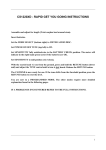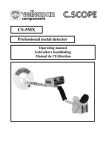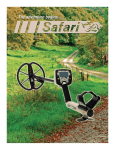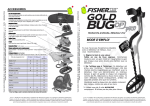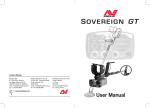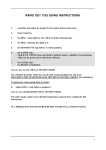Download Velleman CS990XD User manual
Transcript
CS990XD PROFESSIONAL METAL DETECTOR DÉTECTEUR DE MÉTAUX PROFESSIONNEL USER MANUAL NOTICE D’EMPLOI CS990XD – PROFESSIONAL METAL DETECTOR 1.Introduction To all residents of the European Union Important environmental information about this product This symbol on the device or the package indicates that disposal of the device after its lifecycle could harm the environment. Do not dispose of the unit (or batteries) as unsorted municipal waste; it should be taken to a specialized company for recycling. This device should be returned to your distributor or to a local recycling service. Respect the local environmental rules. If in doubt, contact your local waste disposal authorities. Thank you for choosing Velleman! Please read the manual thoroughly before bringing this device into service. If the device was damaged in transit, do not install or use it and contact your dealer. C.SCOPE® detectors are recognised as the finest detectors available. They are designed with lasting quality, high technology, and above all, value for money. The only way to realise this value is to carefully study and understand the instruction manual. You will then be able to obtain all the advantages designed into your detector. It is also strongly recommended that you experiment with the detector’s operation in air using various test samples, in order to learn to identify and understand the detector’s capabilities and responses. Always remember that becoming a good metal detectorist is like becoming a good photographer of fisherman, that is, although it is an advantage to buy the best equipment, having bought it, patience and hours of practice are needed to become proficient. 2.Description A. battery compartment B. upper stem and handle grips C. control box D. stem connecting nut E. cable F. lower stem G.search head and fastener 3.Assembly Insert the lower stem into the upper stem. Tuck the cable into the cable slots in the lower stem to prevent it trailing over the search head. Rotate the lower stem to wrap the cable around the stems and take up any slack and twist the stem lock to hold the lower stem in position. CS990XD 3 VELLEMAN 4.Batteries The CS990XD is powered by eight AA batteries (not supplied). It is advisable to use standard alkaline batteries to start with. You can then evaluate the sort of use you give the detector and decide whether the investment in rechargeable batteries is justified. The batteries should be fitted in the holder which is located in the battery compartment. To fit new batteries first check if the power switch on the unit is switched off. Then loosen the two captive screws located in the battery cover (do not fully remove these from the cover) and remove the cover. Inside is the battery holder. Lift out the battery holder and detach the plug on the connector. Load the holder with eight batteries ensuring that each battery is inserted the correct way round (direction of the batteries alternating as shown on the holder). Roll each individual battery to ensure it is located correctly and making proper contact. Replace the connector making sure that it is well-seated, and put the loaded holder in the housing. Fit the cover and tighten the two captive screws finger tight. Note: Zinc-carbon batteries should not be left in the detector for long periods where they could leak. Remember to remove them at the end of the day’s searching. H. charger socket I. headphones socket J. battery compartment 5.How It Works Inside the CS990XD are two separate detectors operating simultaneously. An “inland” detector which is factory set to ignore mineralised inland ground and gives a positive response to all metals, and a “beach/disc” detector operating at the (adjustable) wet salt sand exclude level, which gives a negative response to iron. By using the switches on the front of the CS990XD to combine the signals from the above two detectors, it is possible for the operator to detect all targets whilst eliminating the effects of the ground, and at the same time distinguishing between the good and the reject targets. Detection is indicated by the loudspeaker sounding off (the loudspeaker is located in the rear of the battery compartment), and by the moving meter needle (in the facia panel). 6.The Controls and What They Do K. signal meter L. on/off switch and tune control M.level control and battery check CS990XD N. ground exclusion switch O.retune push button P. disc mode switch 4 VELLEMAN • On/Off Switch and Tune Control This control is a combined on/off switch and rotary tune control. Fully anticlockwise to the clicked position is power off. To turn the detector on, rotate the control clockwise from its indented off position. To tune the detector, adjust the control to give the preferred level of audio (from the internal loudspeaker or headphones). For best performance, the audio should be adjusted to threshold, when the sound is just beginning to break through, since this is when the ear is most sensitive to small changes, and it is important to maintain this threshold when searching to achieve the maximum depth. The meter gives a visual indication of the audio level (unless battery check or meter disc is selected) and will read midscale when tuned at threshold. The tune control is used in conjunction with the retune button which should be depressed when making adjustments to the controls. • Retune Push Button Should the audio level change during searching other than resulting from a target, such as from drift occurring from warming up, press (and release) the retune button to recover the threshold sound as set on the tune control. The retune button should also be held down when making adjustments to any of the detector’s controls. • Ground Exclusion Switch and Disc Mode Switch Firstly, what is ground exclusion? On some sites mineralisation caused by iron oxides makes it difficult to operate a detector successfully. The effect of these minerals is termed ground effect. In practice, if the detector is not correctly adjusted, the signal alters if the search head is not swept at a constant height above the ground. However, by operating the detector at the correct exclude point this ground signal can be eliminated. The elimination of this signal is known as ground effect exclusion or simply ground exclusion. When operated at the inland ground exclude point, all metals give a positive response so this is sometimes called all-metal mode. What is discrimination (disc)? Like mineralised ground, metals and wet salt sand too, have a characteristic exclude point. By operating the detector at the beach exclude point, iron and small ferrous items produce a negative response, but valuable targets still produce a positive signal. By operating at a higher exclude point, still small pieces of silver (aluminium) paper will also produce a negative (reject) signal. • Level Control The discrimination level of the beach/disc detector in the CS990XD is centred at about that of wet salt sand but can be varied from iron reject through aluminium foil reject by adjusting the level control. (The level control also adjusts the exclude point of the meter disc and meter + audio disc.) • Inland and Disc Mode Switch With inland selected the CS990XD operates at a fixed level of ground discrimination. This inland ground exclude point is factory set on the CS990XD. All metal targets will produce an increase in audio volume in this mode regardless of the level control setting. The beach/disc detector remains operating and can be selected to drive the meter or control the audio pitch by selection on the disc mode switch. The level of discrimination of the beach/disc detector can be adjusted by the level control. The inland mode is used on mineralised inland sites and can be used in conjunction with any one of the disc modes described below. By selecting the meter disc mode the meter needle moves to the right for good targets and to the left for reject targets. By selecting the meter + audio disc mode the meter moves to the right for good targets and to the left for reject targets and the audio pitch increases for good targets and decreases for reject targets. CS990XD 5 VELLEMAN By selecting none the meter needle moves to the right for all targets and the pitch remains constant. • Beach and Disc Mode Switch and Level Control Due to the varying nature of beach soils (the salinity and wetness) the CS990XD is equipped with an adjustable level of ground exclude in beach mode. It is the mode best suited to beach detecting where fine adjustment of the level control is required to exclude wet sand. By selecting the meter disc mode the meter needle moves to the right for good targets and to the left for reject targets. By selecting none the meter needle moves to the right for good targets and to the left for reject targets (same as meter disc since it is ion beach mode). Selecting meter + audio disc gives a pitch increase to good targets, reject targets are ignored. The inland detector plays no part when beach mode is selected and is switched off. Only use the beach mode on the beach or at inland sites where there is no mineralisation and where you do not wish the detector to sound off over iron. It should be apparent from the above that the level control acts primarily as ground exclude control in beach mode, and secondly varies the discrimination point when operating in meter disc or meter + audio disc mode. • Battery Check A battery condition indicator is provided on the detector. To do this for the first time prior to reading the remainder of the operating instructions proceed as follows: turn the power on/off, tune control on. Turn the level control fully anticlockwise to the battery check position. The meter will indicate in the green battery symbol area if the batteries are good. Rechargeable batteries will not read as high into the green as standard batteries even when fully charged. They also give less indication of discharge in the meter during use. Remember to switch out the battery check function when you have checked the batteries. 7.General Hints • Detection Range Your CS990XD is a top performance detector but adverse soil conditions can significantly reduce the depth of detection. Detection ranges will vary depending on the size of the object, the length of time an object has been buried, and the type of ground the object is buried in. The best ground conditions are well compacted soils and coins can be found at the greatest depth if the object has been buried for some time and the coin has interacted with the salts in the ground, thereby appearing larger to the detector. Worst conditions for detecting are on loosely compacted or freshly dug ground or when the object has only recently been buried. In these conditions detection range will be reduced. Ninety percent of all artefacts are found within 15cm of the surface. • Anomalies Iron, unlike a coin, occurs in a multitude of shapes and sizes and as result it is possible that large pieces of iron may give a positive reading. Confusing signals can occur in the first few centimetres below the search head, and are typically characterised by a double signal from the same object, usually iron, which often ranges from a strong positive to a strong negative signal. To overcome these problems simply raise the search head, retuning if necessary, and rescan until a clear signal of rejection or acceptance is obtained. • Headphones Use stereo headphones or mono but not stereo switched to mono. Use of headphones is recommended as it eliminates extraneous noises and will extend battery life. Insertion of headphones automatically mutes the loudspeaker. The 6.35mm (¼”) headphones socket is located on the front of the battery compartment. CS990XD 6 VELLEMAN 8.The Importance of the Right Approach Treasure hunting can be a profitable and rewarding hobby, if approached in a patient and diligent manner. Time spent researching to locate a worthwhile site for a search can be time-wasting if your search is hasty and erratic. To achieve maximum results is important to decide on your approach to any particular site in advance of the actual search. Tactics will be decided by the type of the site – it is more profitable to scan a small area thoroughly than to conduct a haphazard search of the total site. However, when the site is too far away for you to make several return visits, a plan should be adopted which gives maximum coverage, at the same time as indicating the most likely area for detailed search. Your detector alone is not a guarantee of successful treasure hunting. Any detector needs an operator and for the best results the operator needs the right approach, attitude and technique. Many a beginner neglects the importance for preplanning and research before using his detector in the field, and patience and technique during the actual search. A successful search should begin with research some time before the day of the actual search. The extent and thoroughness of your research will be one of the major factors in the success of your detecting. You should aim to get as complete an understanding as possible of the local history and geography. The key of the choice of site is to think of people. Where have people congregated over the past few hundred years? What were their customs and pursuits? Where did they spend money? Where did they carry money? The answers are not Roman sites, nor are they associated with mystical treasure stories of crocks of gold. Rather, they are assuming places like footpaths and ancient rights-of-way, old houses and so on. When you have chosen your site, allocate a whole day from early in the morning to early evening for the search. Make sure you have all the equipment you are likely to need. Your detector should be checked before starting out, and you should always carry a spare set of batteries. You will also need a strong, sharp trowel. It is also a good idea to have a set of lines and pins so that you can lay out your search area scientifically. Most beginners make the mistake of rushing about hoping to chance upon a rare find. If, for example, there happened to be a valuable ring that was buried 10cm deep on the site you were searching, if you rushed about haphazardly and quickly on the site, the odds would be very much against you finding it. On the other hand, if you pegged out the area scientifically and searched slowly and thoroughly, the odds of finding the ring would be very much in your favour. Remember, BE PATIENT and WORK SLOWLY. Do not try to cover too large an area, restrict yourself to a small area and work through it thoroughly. Make a note of the position and the extent of the area, and the when you return you can start again further on without missing any ground or covering the same area twice. It is also important to keep the detector as close to the ground as possible. Ideally, you should “iron” the ground with the search head of the detector, so that you do not lose any detection range. Similarly, if you work slowly and carefully you should be able to distinguish the faint signals as well as the clear-cut signals and further increase your finds. The technique of getting the best out of your detector is not learnt overnight. You need to get as much experience as possible so that you can recognise every kind of signal. Indeed, a good detector operator can often tell you what is being detected before it is unearthed. Search head position: It is essential that the search head is kept as close and parallel to the ground as in B. Do not hold the search head too high above the ground, or at an angle as in A, C and D as you may miss out on finds. CS990XD 7 VELLEMAN 9.Code of Conduct 1. Do not trespass. Ask permission before venturing on to any private land. 2. Respect the Country Code. Do not leave gates open when crossing the fields, and do not damage crops or frighten animals. 3. Do not leave a mess. It is simple to extract a coin or other small objects buried a few inches under the ground without digging a great hole. Use a sharpened trowel or knife to cut a neat circle or triangle (do not remove the plug of earth entirely from the ground): extract the object, replace the soil and grass carefully and evenly. 4. Help to keep your country tidy. Bottle tops, silver paper and tin cans are the last thing you should throw away. You could well be digging them up again next year. Do yourself and the community a favour by taking the rusty iron and junk you find to the nearest litter bin. 5. If you discover any live ammunition or any lethal objects such as an unexploded bomb or mine, do not touch it. Mark the site carefully and report the find to the local police. 6. Report any unusual historical finds to the landowner. 7. Familiarise yourself with the law relating to the archaeological sites. Remember it is illegal for anyone to use a metal detector on a scheduled ancient monument unless permission has been obtained from the Historic Buildings and Ancient Monument Commission for England or the Secretary of State for the Environment in Scotland and Wales. 8. Remember that when you are out with your metal detector, you are an ambassador for your hobby. Do nothing that may give it a bad name. 9. The law relating to treasure finds must be followed. Contact the authorities and inform yourself. 10. Care for Your Detector When not in use your detector should be stored in a dry and warm environment. If it is not to be used for a certain length of time it is advisable to remove the batteries to avoid leakage which could cause serious damage. The working life of your detector will be shortened by careless use or neglect of the unit. Think of your detector as a scientific instrument. Your detector is designed to withstand rugged handling on any terrain, but misuse or lack of due attention will tell in the end. After using your detector in a hostile environment (salt water, sand, etc.) the exterior parts should be rinsed with clean fresh water, paying particular attention to the head and stems, then carefully wipe dry. 11. Troubleshooting Problem Meter needle does not move as you adjust the tune control Meter needle appears to be stuck New batteries fitted but unit will not switch on New batteries fitted but battery check reading indicates low Detector is switched on but appears not to be working Detector does not work on headphones Possible Cause The detector is in meter disc mode or meter + audio disc mode The level control switch has been left in battery check position Batteries are not making contact in the battery holder One battery inserted incorrectly Headphone adapter left in headphone socket Stereo/mono headphones switched to mono Solution Switch mode to none Switch out battery check mode Remove the battery holder and roll out the individual batteries in the holder Remove the battery holder and reverse incorrect battery Remove the adapter Switch headphone to stereo Use this device with original accessories only. Velleman nv cannot be held responsible in the event of damage or injury resulted from (incorrect) use of this device. For more info concerning this product, please visit our website www.velleman.eu. The information in this manual is subject to change without prior notice. CS990XD 8 VELLEMAN CS990XD – PROFESSIONAL METAL DETECTOR 1.Introduction Aux résidents de l'Union européenne Des informations environnementales importantes concernant ce produit Ce symbole sur l'appareil ou l'emballage indique que l’élimination d’un appareil en fin de vie peut polluer l'environnement. Ne pas jeter un appareil électrique ou électronique (et des piles éventuelles) parmi les déchets municipaux non sujets au tri sélectif ; une déchèterie traitera l’appareil en question. Renvoyer les équipements usagés à votre fournisseur ou à un service de recyclage local. Il convient de respecter la réglementation locale relative à la protection de l’environnement. En cas de questions, contacter les autorités locales pour élimination. Nous vous remercions de votre achat ! Lire la présente notice attentivement avant la mise en service de l’appareil. Si l’appareil a été endommagé pendant le transport, ne pas l’installer et consulter votre revendeur. Les détecteurs de métaux C.SCOPE® sont des détecteurs mondialement connus comme étant des détecteurs haute qualité intégrant une technologie supérieure et d’un excellent rapport qualité-prix. Vous réaliserez l’ampleur de votre achat en lisant attentivement cette notice qui vous expliquera comment profiter de toutes les fonctions de ce détecteur. Nous vous conseillons d’expérimenter avec son fonctionnement à l’extérieur en utilisant de nombreux échantillons afin d’apprendre à identifier les signaux émis par le détecteur. N’oubliez pas que le chemin du prospecteur compétent est similaire à celui du photographe ou du pêcheur : s’il est toujours un avantage à acheter le meilleur matériel sur le marché, c’est sans aucun doute la patience et des heures de prospection qui seront la clef du succès… 2.Description A. compartiment des piles B. haut de canne et poignée C. unité de commande D. raccord des cannes E. câble F. bas de canne G.disque et raccord 3.Assemblage Insérez le bas de canne dans le haut de canne. Passez le câble dans les fentes du bas de canne afin d’éviter qu’il ne traîne sur le disque. Tournez le bas de canne pour que le câble s’enroule autour de la canne. Resserrez et tournez le raccord de la canne afin de fixer le bas de canne. CS990XD 9 VELLEMAN 4.Les piles Le CS990XD est alimenté par huit piles de type R6 (not incluses). Nous vous conseillons d’utiliser des piles alcalines standards. Au fur et à mesure de la fréquence d’utilisation vous pourrez envisager à investir dans des piles rechargeables. Les piles doivent être installées dans le support de piles situé dans le compartiment des piles. Vérifiez d’abord si l’interrupteur de puissance est désactivé. Desserrez les deux vis imperdables dans le couvercle (ne pas retirer les vis du couvercle) et retirez le couvercle afin de découvrir le support de piles. Sortez le support de piles du compartiment et déconnectez. Insérez les huit piles dans le support en respectant la polarité (direction des piles comme mentionné sur le support). Veillez à ce que les pôles des piles soient en contact avec les bornes en roulant les piles. Reconnectez le support de piles et replacez-le dans le compartiment. Réinstallez le couvercle et serrez les deux vis. Remarque : Ne laissez jamais des piles salines (zinc-carbone) dans le détecteur pendant une période prolongée afin d’éviter tout risque d’écoulement. Retirez-les du détecteur après usage. 5.Comment sa marche H. prise de recharge I. prise pour casque J. compartiment des piles Le CS990XD intègre deux détecteurs séparés fonctionnant simultanément : un détecteur de terre « inland » pré-calibré qui ignore le sol minéralisé et qui donne un signal positif à tous les métaux, et un détecteur de plage « beach/disc » avec un niveau d’exclusion (réglable) pour le sable salé mouillé et donnant un signal négatif au fer. En combinant les signaux des deux détecteurs à l’aide des commandes du CS990XD, vous pourrez détecter des cibles tout en éliminant les effets de sol et simultanément faire une distinction entre une cible à accepter ou à rejeter. Une détection est indiquée par un bip sonore provenant du haut-parleur (le haut-parleur se trouve à l’arrière du compartiment des piles), et par l’aiguille du vumètre (su le panneau frontal). 6.Les commandes et leur fonction K. vumètre N. interrupteur d’exclusion des effets de sol L. interrupteur marche/arrêt et bouton de syntonisation O.bouton de réinitialisation M.bouton de réglage de niveau et témoin de niveau des piles P. sélecteur de mode de discrimination CS990XD 10 VELLEMAN • Interrupteur marche/arrêt et bouton de syntonisation Ce bouton combine l’interrupteur marche/arrêt et un syntoniseur. Tournez ce bouton entièrement vers la gauche pour éteindre le détecteur. Allumez le détecteur en tournant le bouton vers la droite : vous entendrez un déclic. Syntonisez en ajustant le bouton jusqu’au niveau audio souhaité (depuis le haut-parleur ou le casque d’écoute). Pour les meilleurs résultats, ajustez l’audio jusqu’au seuil (là où le son commence à être audible). Il est important de maintenir ce seuil lors de la détection afin d’obtenir la profondeur maximale. Le vumètre affiche une indication visuelle du niveau audio (sauf si le témoin de niveau des piles ou la discrimination est activé) en plaçant l’aiguille au milieu lorsque le détecteur est syntonisé sur le seuil sonore. Utilisez le bouton de syntonisation en combinaison avec le bouton de réinitialisation. • Bouton de réinitialisation Enfoncez (et relâchez) le bouton de réinitialisation afin de réinitialiser le seuil sonore lors d’une modification du niveau audio résultant d’un phénomène autre que la découverte d’une cible. Maintenez enfoncé le bouton de réinitialisation lorsque vous actionnez une des commandes. • Interrupteur d’exclusion des effets de sol et Switch and Disc Mode Switch D’abord, qu’est-ce que l’exclusion des effets de sol ? Certains sites rendent la détection difficile à cause de la minéralisation du sol due aux oxydes de fer. Cet effet est communément appelé l’effet de sol. En réalité, si le détecteur n’est pas bien calibré, le signal modifie lorsque vous ne balayez pas le disque à ras le sol. Cependant, en calibrant le détecteur, vous éliminerez ce signal provenant du sol. On appelle l’élimination du signal l’exclusion des effets de sol. En mode terre, tous les métaux donnent un signal positif. Qu’est-ce que la discrimination (disc) ? Tout comme un sol minéralisé, les métaux et le sable salé mouillé ont également un point d’exclusion. En utilisant le détecteur en mode plage, le fer et les éclats ferreux donneront un signal négatif contrairement aux objets dis de valeurs qui donneront un signal positif. Un calibrant le détecteur sur un point d’exclusion plus élevé, les petits objets en argent (aluminium) donneront également un signal négatif. • Niveau de discrimination Le niveau de discrimination du détecteur de plage du CS990XD est pré-calibré sur du sable salé mouillé mais peut être calibré sur un niveau de rejection d’éclats de fer ou d’aluminium. (Le bouton de réglage de niveau calibre également le point de discrimination « meter disc » et « meter + audio disc ».) • Mode terre et sélecteur de mode de discrimination En mode terre, le CS990XD fonctionne à un niveau de discrimination fixe étalonné par le fabricant. Toutes les cibles métalliques émettront un signal sonore supérieur quel que soit le niveau instauré. Le détecteur de plage reste activé et peut être sélectionné pour alimenter le vumètre ou pour régler le niveau sonore avec le sélecteur de mode de discrimination. Le niveau de discrimination du détecteur de plage peut être réglé avec le bouton de réglage de niveau. Le mode terre est utilisé pour la détection sur un terrain minéralisé et peut fonctionner en combinaison avec un des modes de discrimination ci-dessous. Sélection du mode « meter disc » : l’aiguille se déplace vers la droite pour des cibles à accepter et vers la gauche pour des cibles à rejeter. Sélection du mode « meter + audio disc » : l’aiguille se déplace vers la droite pour des cibles à accepter et vers la gauche pour des cibles à rejeter. Le niveau sonore augmente pour des cibles à accepter et diminue pour des cibles à rejeter. Sélection du mode « none » : l’aiguille se déplace vers la droite pour toutes les cibles et le niveau sonore reste constant. CS990XD 11 VELLEMAN • Mode plage et sélecteur de mode de discrimination et bouton de réglage de niveau Le CS990XD possède un niveau de discrimination ajustable en mode plage, ce qui s’avère pratique lors de la prospection sur du sable. À cause de la nature variante du sable (salinité et humidité) un peaufinage du niveau de discrimination peut éliminer les signaux provenant du sable. Sélection du mode « meter disc » : l’aiguille se déplace vers la droite pour des cibles à accepter et vers la gauche pour des cibles à rejeter. Sélection du mode « none » : l’aiguille se déplace vers la droite pour des cibles à accepter et vers la gauche pour des cibles à rejeter (identiquement au mode « meter disc » puisque le détecteur se trouve en mode plage). Sélection du mode « meter + audio disc » : le niveau sonore augmente pour des cibles à accepter et les cibles à rejeter sont ignorés. Le détecteur de terre ne joue aucun rôle en mode plage et sera donc désactivé. N’utilisez le mode plage que sur les plages et sur des terrains sans minéralisation et là où vous ne désirez pas que le détecteur vous signale la présence d’un objet ferreux. Bref : le bouton de réglage du niveau sert principalement comme éliminateur des effets de sol en mode plage et comme régulateur de niveau de discrimination en mode « meter disc » ou « meter + audio disc ». • Témoin de niveau des piles Le détecteur est équipé d’un témoin de niveau des piles. Effectuez un essai avant chaque détection : allumer le détecteur à l’aide de l’interrupteur marche/arrêt et placer le bouton de syntonisation sur le mode de témoin de niveau des piles. L’aiguille se positionne dans le niveau vert si les piles sont assez puissantes. Notez que des piles rechargeables n’afficheront jamais un niveau aussi que celui de piles standards, même lorsqu’elles sont entièrement rechargées. Elles afficheront également un niveau d’use inférieure. N’oubliez pas de désactiver la fonction après la vérification du niveau des piles. 7.Quelques tuyaux • Plage de détection Votre CS990XD est un détecteur de métaux haute qualité. Cependant, des conditions de sol difficiles peuvent considérablement réduire la profondeur de détection. La plage de détection varie selon la taille de la cible, la période d’enterrement de la cible et le type de sol dans lequel la cible est enterrée. Les sols les plus propices à la prospection sont des sols bien compacts. Vous détecterez une pièce de monnaie à une grande profondeur, la cible ayant réagit avec les minéraux dans le sol et émettant ainsi un signal plus fort. Les sols diminuant la plage de détection sont des sols moins compacts ou fraîchement labourés, ou lorsque la cible a été enterrée récemment. Quatre-vingt-dix pourcent des trouvailles sont font à une profondeur de 15 cm. • Anomalies Le fer, contrairement à une pièce de monnaie, se présente sous diverses formes. Par conséquent, il est possible qu’un objet en fer de grande taille émette un signal positif. Des signaux perturbants peuvent se situer à quelques centimètres sous le disque et sont caractérisés par un double signal positif et négatif, généralement provenant du fer. Pour y remédier, levez simplement le disque, réinitialisez si nécessaire, et balayez jusqu’à ce que le signal indique clairement une rejection ou une acceptation. • Casque d’écoute Utilisez un casque stéréo ou mono et évitez un casque stéréo utilisé en mono. Nous conseillons l’utilisation d’un casque puisqu’il élimine les bruits étrangers et prolongera la durée de vie des piles. Le raccordement d’un casque coupera automatiquement le haut-parleur. La prise 6,35 mm (¼”) se trouve sur la partie frontale du compartiment des piles. CS990XD 12 VELLEMAN 8.L’importance d’une bonne approche La chasse au trésor est un loisir lucratif à condition de le pratiquer avec dévouement et de la patience. Le temps consacré à la recherche d’un site qui en vaut la peine peut être très long si votre recherche est précipitée et mal organisée. Il est donc important de préparer votre approche. Cette approche dépendra du type de site – vous aurez plus de succès en scrutant un petit bout de parcelle de manière profonde qu’en balayant nonchalamment un champ entier. Dessinez un plan indiquant les parcelles déjà scrutées et les parcelles propices aux trouvailles. Un bon détecteur ne garantit pas du succès dans votre chasse au trésor. Tout détecteur est tributaire de son prospecteur. Il faut donc nécessairement avoir une bonne approche, une bonne attitude et une excellente technique. Trop de débutants négligent l’importance d’une préparation et d’une recherché au préalable avant de s’aventurer sur un site, et de la patience et de la technique sur le site-même. Commencez par planifier votre recherche. La profondeur de votre recherche est un facteur majeur du succès. Essayez de comprendre le plus possible de l’histoire et la géographie locales. Il s’agit donc de choisir le site en étudiant un peuple. Quel lieu pourrait avoir été choisi comme lieu de rencontre ? Quelles étaient les habitudes ? Où ce peuple a-t-il dépensé de l’argent ? Ne cherchez pas sur des sites présumés Romains mais préférez les vieux sentiers, anciennes maisons, etc. Une fois le site choisi, réservez une journée entière à partir du petit matin jusqu’au soir pour la recherche. Contrôlez votre détecteur avant de partir. Veillez à emmener le matériel nécessaire tout comme un jeu de piles de rechange, une truelle, de la corde et des piquets pour délimiter les parcelles… La plupart des débutants espèrent trouver une pièce de grande valeur. Une bague enterrée à une profondeur de 10 cm dans un champ restera introuvable si vous vous y précipitez sans préparation. En répartissant le champ en parcelles et en balayant lentement et profondément, vous aurez plus de chance de déterrer la pièce. N’oubliez pas d’être PATIENT et de PROCÉDER LENTEMENT. Ne couvrez pas de superficie trop étendue, limitez-vous à une petite parcelle et balayez profondément. Notez les parcelles déjà scrutées afin d’éviter de les scruter une deuxième fois. Avant tout il est important de tenir le disque de manière correcte, c’est à dire à ras du sol. Idéalement, balayez avec le disque à ras du sol de manière régulière est pas trop lente. Vous distinguerez les signaux faibles des signaux plus forts, ce qui augmentera les chances d’une trouvaille. La technique de balayage exige beaucoup d’exercice et ne s’apprend pas du jour au lendemain. Il faut acquérir le plus d’expérience possible afin de reconnaître toutes sortes de signaux. Un prospecteur expérimenté devine la nature de la cible avant même de l’avoir déterrée ! Position du disque : Tenez le disque à ras le sol comme illustré (B). Évitez de balayer à une hauteur trop importante (C) ou dans un angle (A, D) afin de na pas manquer les signaux émis par une cible. CS990XD 13 VELLEMAN 9.Code de conduite 1. N’entrez sur les terrains qu’après avoir demandé et obtenu la permission du propriétaire ou du gardien. 2. Dans les champs et les prés, refermez les barrières que vous avez franchies, surtout s’il y a des animaux à proximité. Restez le plus discret possible vis-à-vis des animaux. Respectez les plantations, ne pénétrez pas dans un champ en train ou ayant déjà levé. 3. Rebouchez les trous que vous faites lors de votre prospection. Les performances du matériel actuel vous permettent de localiser précisément une monnaie ou un objet. Ne faites pas un trou de 50 cm sur 50 cm pour extraire une pièce ! 4. Votre passion à une vocation écologique. Laissez les endroits où vous détectez exempts des déchets que vous avez pu extraire et prévoyez un sac à déchets à cet effet. Mieux vaut les jeter à la poubelle que de les retrouver enfouis à la prochaine détection. Ne jetez surtout pas vos piles dans la nature ! 5. Prévenez immédiatement la police locale ou la gendarmerie nationale si vous vous trouvez confrontés à un objet suspect (obus, bombe ou grenade non explosés). Laissez l’objet sur place sans y toucher, mais ne le laissez jamais sans surveillance dans les endroits fréquentés. 6. En cas de découverte fortuite d’objets pouvant intéresser l’archéologie, informez-en la DRAC ou, à défaut, la mairie du lieu concerné. 7. Familiarisez-vous avec la législation sur les sites archéologiques. N’oubliez qu’il est interdit d’effectuer des fouilles sur un terrain pouvant intéresser la préhistoire, l’histoire, l’art ou l’archéologie sans en avoir reçu au préalable l’autorisation préfectorale. 8. Prenez à cœur votre rôle d’ambassadeur des prospecteurs. Donnez une image positive de la prospection : c’est de votre attitude que dépendra peut-être la survie et/ou la reconnaissance de votre passion ! 9. Apprenez la législation sur la découverte fortuite de trésor auprès des autorités locales. 10. Entretien de votre détecteur Stockez votre détecteur dans un endroit sec et à l’abri du froid après usage. Pour éviter tout risque d’écoulement, retirez d’abord les piles si vous n’emploierez pas le détecteur pendant une période prolongée. Sa durée de vie sera considérablement écourtée en négligeant le détecteur. Considérez-le comme un instrument scientifique. Bien qu’il soit conçu pour un usage dans des circonstances rudes dans tous les environnements et dans tous les climats, un mauvais usage et le manque d’entretien détériora le détecteur. Nettoyez l’extérieur du détecteur, et en particulier le disque et la canne, avec de l’eau claire après un usage dans sur terrain hostile (eau salée, sable, etc.). Essuyez avec un chiffon sec. 11. Problèmes et solutions Problème Aiguille du vumètre immobile lors du réglage the tune control Aiguille du vumètre semble être bloquée Détecteur ne s’allume pas après insertion de nouvelles piles Témoin de niveau des piles indiquant une faible puissance après insertion de nouvelles piles Détecteur est allumé mais ne semble pas fonctionner Détecteur ne semble pas fonctionner avec casque d’écoute Cause probable Détecteur en mode de discrimination « meter disc » ou « meter + audio disc » Bouton de réglage de niveau en mode témoin de niveau des piles Piles insérées incorrectement Une des piles insérée incorrectement Casque d’écoute connecté au détecteur Casque d’écoute stéréo/mono en mono Solution Placez l’interrupteur sur « none » Désactivez le mode témoin de niveau des piles Retirez le support des piles et réinsérez dûment les piles Retirez le support des piles et réinsérez dûment la pile Déconnectez le casque d’écoute Placez le casque d’écoute en mode stéréo N’employer cet appareil qu’avec des accessoires d’origine. SA Velleman ne sera aucunement responsable de dommages ou lésions survenus à un usage (incorrect) de cet appareil. Pour plus d’information concernant cet article, visitez notre site web www.velleman.eu. Toutes les informations présentées dans cette notice peuvent être modifiées sans notification préalable. CS990XD 14 VELLEMAN
This document in other languages
- français: Velleman CS990XD

















